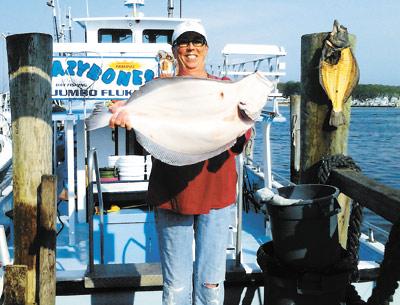Doormats, Bass, Glowing Tuna

Last week, charter captains and private boaters sailing out of Montauk were finding striped bass, bass, bass. Nice plump ones. This week, the bass flurry slowed, but the slack was taken up by some doormat-size fluke and vast schools of bluefish. Then, there’s the news from California about radioactive bluefin tuna. Read on.
The Lazy Bones party boat has been hot with left-handed flounder with fish up to nine pounds. If you stand them on edge, summer flounder, or fluke, have both eyes on the left side; the upward-gazing eyes of winter flounder are on the right side.
During last Wednesday’s morning and afternoon trips, Lazy Bones anglers caught 8 to 10 keeper fluke measuring at least 20.5 inches long. Kathy Vegessi, shoreside support for the Bones, took a busman’s holiday on Sunday and was rewarded with an 8.5-pounder. “It was a long time coming,” she said of both hooking into a sizable doormat, and of getting the big fish off the bottom.
“Becky [Vegessi, her daughter and one of the Bones’s mates] kept screaming at me, ‘You’ve got to keep reeling. Did you forget how?’ ” She did not. Her secret? “Two strips of squid, two spearing, and a white teaser.”
Scott Leonard of the Star Island Yacht Club reported no weigh-ins yet in the Montauk SurfMasters spring shootout tournament, although one lucky (or masterful) caster not in the contest found a 33-pound striper under the Montauk Lighthouse using a needlefish lure.
Star Island’s private boaters did well on stripers over the weekend. A slower pace was made up for in size. Two fish hit the Star Island scales at 30 and 36 pounds. The marina’s first shark tournament of the year, its 26th annual, will take place on June 15 and 16, with the captains meeting on the 14th.
May and June is the time of year when bluefin tuna make their appearance off Montauk on their annual migration from the Gulf of Mexico to the Gulf of Maine and Canada’s Atlantic provinces.
No news yet of any local sightings, but a very troubling report about bluefin in the Pacific is found in a study undertaken by Stony Brook University in cooperation with Stanford University’s Hopkins Marine Station. The study has found that migrating Pacific bluefin are carrying radioactivity to the waters off California after being exposed in the ocean to leaks from the Fukushima Dai-ichi nuclear plants. The plants were damaged during the earthquake and tsunami in March 2011.
The contamination does not pose a health threat. You will not glow if you eat sushi. Levels are relatively low, the study found. But, the findings represent the first documented case of radioactivity being transported in the sea through biological migration. The study, “Pacific Bluefin Tuna Transport Fukushima-Derived Radionuclides From Japan to California” has been published in Proceedings of the National Academy of Sciences of the U.S.
The radioactive tuna may not grow to Godzilla size, but they could have a marked effect on the price of prized sushi flesh. Radioactive conservation. Time will tell.
